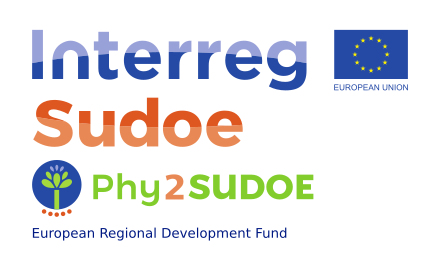The project is divided into 6 work packages, 3 technical (GTs) and 3 transversal (GT.Ts):
Work Packages
Technical Work Packages (GT)
GT1: Long-term maintenance and monitoring of PhytoSUDOE network sites using harmonised methodology.
GT1 will focus on the maintenance of the PhytoSUDOE sites, as well as on implementing long-term monitoring strategies to track the benefits brought by phytomanagement. If setbacks in pollution control are detected, corrective phytomanagement options will be implemented. Maintenance protocols and monitoring tools validated in this GT will be transferred to GT2.
Objectives
- Evaluate the EFFECTIVENESS of long-term phytomanagement options and correct pollution control deviations (CSIC, UPV, CEA, INRAE, Fertil, Charente, UCP, Clover).
- Design and implement long-term protocols for the MAINTENANCE of phytomanaged areas (NEIKER, CSIC, CEA, INRAE, UCP, Charente, Clover).
- Design and implement tools for the long-term MONITORING of phytomanaged areas (NEIKER, USC, UPV, UCP, INRAE).
The beneficiaries based in the areas where the sites are located are responsible for the measures to be carried out in situ and for taking samples. The results will reflect the state of the PhytoSUDOE network of phyto-managed sites (soil properties, bioavailability of pollutants, risks and residual pollution links, etc.), as well as the selected long-term monitoring tools and the proposals for improvement of good practice protocols for the long-term maintenance of the network.
GT2: Expansion of the PhytoSUDOE network: addition of new sites and phyto-management options under a variety of soil and climatic conditions
GT2 will extend the current network of phyto-management sites in the SUDOE region, demonstrating the effectiveness and limits of phytotechnologies to remediate contaminated soils. The current PhytoSUDOE network (8 sites) will be joined by 8 new sites with new casuistry (other land uses, organic pollutants, mixed contamination) in different soil and climatic conditions.
These will include new mining areas and urban and industrial areas in order to widen the range of future uses (peri-urban green belts, parks, industrial crops, etc.). These sites depend on the administrations and companies of the partnership and associated partners, thus facilitating the transfer of results. New phytomanagement solutions will be implemented according to the PhytoSUDOE methodology.
Objectives
- Assess pollution links: sources, exposure routes and risks (INRAE, CSIC, USC,
UCP, UPV, NEIKER, Clover). - Feasibility of solutions based on phytotechnologies (NEIKER, USC, CSIC, UPV, CEA, INRAE, Fertil,
Charente, UCP, Clover). - Remediation / phyto-management strategies: operation plan, evidence of effectiveness, benefits / limitations of crops, functions and services constraints, soil functions and services (NEIKER, USC, CSIC, UPV, CEA, INRAE,
Fertil, Charente, UCP, Clover).
The results will reflect the conformation and status of the new extended network of PhytoSUDOE Network phyto-managed sites (PhytoSUDOE sites + Phy2SUDOE sites).
GT3: Identification and conservation of endemic biodiversity of contaminated sites for potential exploitation in biotechnological applications
GT3 focuses on the conservation (in situ and ex situ) and promotion of biodiversity at mining sites. Efforts will focus on the conservation of metal plants and metallophytes, as well as other organisms (animals, micro-organisms) adapted to environments with high levels of metals, for future biotechnological applications, among them:
- Phytoremediation and phytomanagement (UPV).
- The use of metal-resistant plant growth promoting bacteria and fungi (UCP, NEIKER).
- The use of invertebrates as environmental sentinels in metal-contaminated areas (UPV, Clover).
For in situ conservation of plants, physical barriers and rehabilitation measures will be established (UPV, USC, CSIC, UCP, INRAE). For ex situ conservation of plants, germplasm and tissue conservation banks will be used (CEA, UPV). Bacteria and fungi will be isolated, characterised according to their ability to promote plant growth (UCP, NEIKER) and stored in a biobank (NEIKER, UCP, UPV). The potential of macroinvertebrates (earthworms, slugs, snails) present at the sites will be assessed as environmental sentinels (UPV, INRAE, Clover) and a selection of their tissues will be stored in a biobank of environmental specimens (UPV).
Transversal Work Packages (GT.T)
GT.T1: Project management
GT.T1 will devote to:
- the administrative management and daily coordination of the project,
- political and technical decision-making,
- project’s internal communication,
- the internal organisation to produce performance reports,
- project’s economic management.
GT.T2: Project communication
GT.T2 will coordinate dissemination and communication activities.
It will be focused on three different stakeholders´ groups:
- scientific community,
- stakeholders and end-users, including legislators and decision makers,
- general public.
The communication plan developed in this work package will enable an effective transfer of results to relevant administrative bodies, regulators, SMEs and industry, local communities and general public.
GT.T3: Monitoring and evaluation of the project
GT.T3 activities include creating a procedure for the monitoring and evaluation of the project as well as for the risk management and quality control. It will also be responsible of the project’s progress monitoring.

